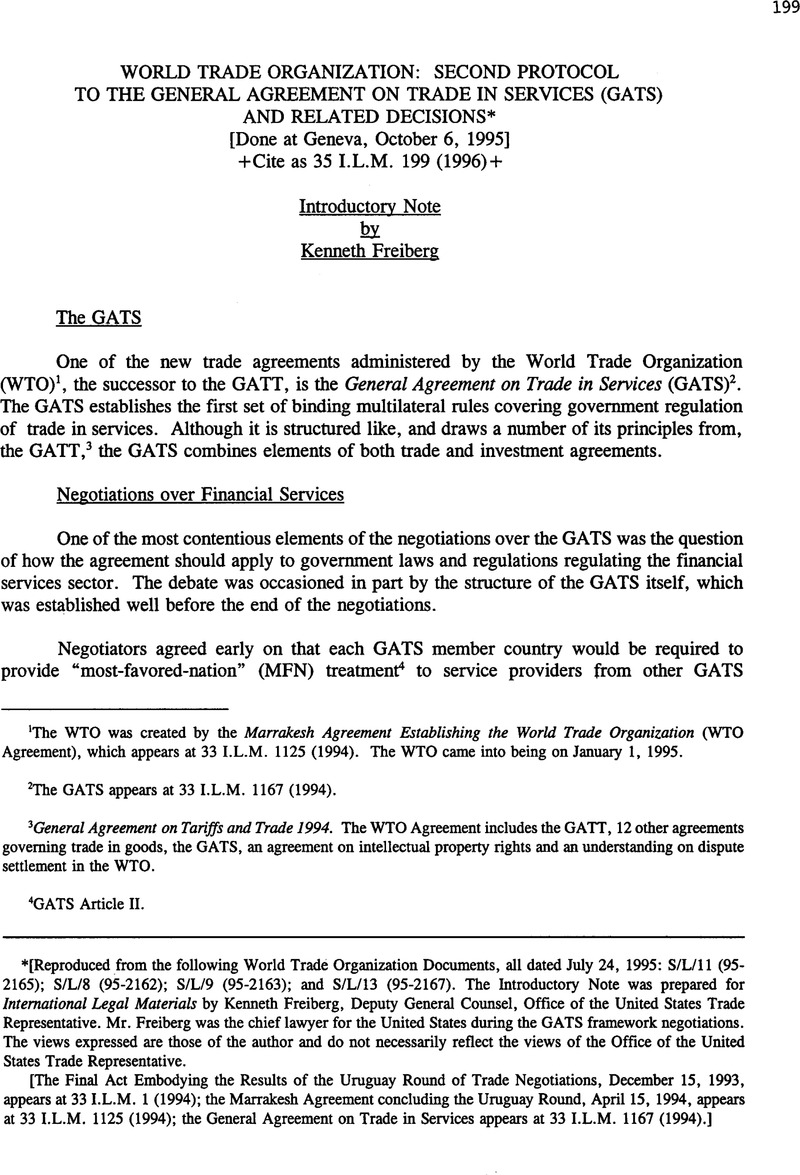Published online by Cambridge University Press: 18 May 2017

[Reproduced from the following World Trade Organization Documents, all dated July 24, 1995: S/L/ll (95- 2165); S/L/8 (95-2162); S/L/9 (95-2163); and S/L/13 (95-2167). The Introductory Note was prepared for International Legal Materials by Kenneth Freiberg, Deputy General Counsel, Office of the United States Trade Representative. Mr. Freiberg was the chief lawyer for the United States during the GATS framework negotiations. The views expressed are those of the author and do not necessarily reflect the views of the Office of the United States Trade Representative. [The Final Act Embodying the Results of the Uruguay Round of Trade Negotiations, December 15, 1993, appears at 33 I.L.M. 1 (1994); the Marrakesh Agreement concluding the Uruguay Round, April 15, 1994, appears at 33 I.L.M. 1125 (1994); the General Agreement on Trade in Services appears at 33 I.L.M. 1167 (1994).]
1 The WTO was created by the Marrakesh Agreement Establishing the World Trade Organization (WTO Agreement), which appears at 33 I.L.M. 1125 (1994). The WTO came into being on January 1, 1995.
2 The GATS appears at 33 I.L.M. 1167 (1994).
3 General Agreement on Tariffs and Trade 1994. The WTO Agreement includes the GATT, 12 other agreements governing trade in goods, the GATS, an agreement on intellectual property rights and an understanding on dispute settlement in the WTO.
4 GATS Article II.
5 GATS Art. XVI. The GATS “market access” provision requires countries to refrain from imposing certain types of quotas and other quantitative restrictions, or local incorporation requirements, in service sectors that those countries list in their GATS schedules. The idea is to prohibit “needs tests” and other devices that governments use to limit market entry or otherwise restrain market competition.
6 GATS Article XVII. The national treatment rule requires countries to avoid discriminating in favor of domestic service providers.
7 Under the GATS, quantitative restrictions and discrimination in favor of domestic firms are treated much like tariffs under the GATT — that is, candidates for reduction or elimination in successive negotiating rounds. Sectoral commitments to observe market access and national treatment rules are recorded in country “schedules” annexed to the GATS, much like the GATT tariff schedules appended to the GATT.
8 The United States made essentially the same argument with respect to the basic telecommunications market
9 This view was based on the argument that: 1) the MFN rule would prohibit countries with open markets from closing them on a selective basis to firms from other GATS countries; and 2) countries with open markets would not want to threaten closing them to firms from all GATS countries merely to extract negotiating concessions from a few governments. Based on these arguments, the United States ultimately succeeded in securing a provision in the GATS that permitted countries to take limited exceptions to the MFN rule.
10 These interim arrangements were spelled out in the Second Annex on Financial Services appended to the GATS and a ministerial decision on financial services taken in Marrakesh at the time the WTO Agreement was signed. The decision was included in the package of legal documents that embody the results of the Uruguay Round. The collected set of legal texts is available from the WTO Secretariat in Geneva.
11 The deadline for countries formally to transmit their revised schedules was extended until July 28,1995.
12 Second Protocol to the General Agreement on Trade in Services, WTO Doc. S/L/ll (July 24, 1995). The Second Protocol will enter into force either when all countries participating in the protocol have accepted it or, if some acceptances are lacking by July 1, 1996, within 30 days thereafter by agreement of those countries that have accepted.
13 Some countries, like the United States, amended their schedules during the extended negotiating period to make changes in their market access and MFN obligations for financial services. Other countries simply left their commitments in effect.Ifthe protocol does not go into force by August 1, 1996, all WTO members will be free to modify their market access commitments and MFN undertakings over the following 60 days. This contingency, provided for in a GATS Council decision, is designed to protect those countries that structured their commitments in anticipation of the entry into force of the protocol.Decision on Commitments in Financial Services, WTO Doc. S/L/8, para. 1 (July 24, 1995).
14 During the period before it takes effect, countries that pledged to join the protocol are obliged to observe their protocol commitments, to the extent that domestic law permits. Decision Adopting the Second Protocol to the General Agreement on Trade in Services, WTO Doc. S/L/13, para. 2 (July 24, 1995).
15 Second Decision on Financial Services, WTO Doc. S/L/9 (July 24, 1995).